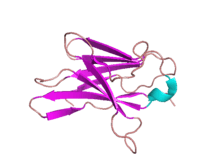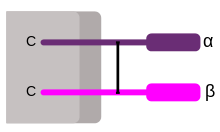CD8
| CD8a molecule | |
|---|---|
 Crystallographic structure of the CD8 molecule.[1] | |
| Identifiers | |
| Symbol | CD8A |
| Alt. symbols | CD8 |
| Entrez | 925 |
| HUGO | 1706 |
| OMIM | 186910 |
| RefSeq | NM_001768 |
| UniProt | P01732 |
| Other data | |
| Locus | Chr. 2 p12 |
| CD8b molecule | |
|---|---|
| Identifiers | |
| Symbol | CD8B |
| Alt. symbols | CD8B1 |
| Entrez | 926 |
| HUGO | 1707 |
| OMIM | 186730 |
| RefSeq | NM_172099 |
| UniProt | P10966 |
| Other data | |
| Locus | Chr. 2 p12 |
CD8 (cluster of differentiation 8) is a transmembrane glycoprotein that serves as a co-receptor for the T cell receptor (TCR). Like the TCR, CD8 binds to a major histocompatibility complex (MHC) molecule, but is specific for the class I MHC protein.[2] There are two isoforms of the protein, alpha and beta, each encoded by a different gene. In humans, both genes are located on chromosome 2 in position 2p12.
Tissue distribution
The CD8 co-receptor is predominantly expressed on the surface of cytotoxic T cells, but can also be found on natural killer cells, cortical thymocytes, and dendritic cells. It is expressed in T cell lymphoblastic lymphoma and hypo-pigmented mycosis fungoides.[3]
Structure
To function, CD8 forms a dimer, consisting of a pair of CD8 chains. The most common form of CD8 is composed of a CD8-α and CD8-β chain, both members of the immunoglobulin superfamily with an immunoglobulin variable (IgV)-like extracellular domain connected to the membrane by a thin stalk, and an intracellular tail. Less-common homodimers of the CD8-α chain are also expressed on some cells. The molecular weight of each CD8 chain is about 34 kDa.[4] The structure of the CD8 molecule was determined by Leahy, D.J., Axel, R., and Hendrickson, W.A. by X-ray Diffraction at a 2.6A resolution.[1] The structure was determined to have an immunoglobulin-like beta-sandwich folding and 114 amino acid residues. 2% of the protein is wound into α-helices and 46% into β-sheets, with the remaining 52% of the molecules remaining in the loop portions.

Function
The extracellular IgV-like domain of CD8-α interacts with the α3 portion of the Class I MHC molecule.[5] This affinity keeps the T cell receptor of the cytotoxic T cell and the target cell bound closely together during antigen-specific activation. Cytotoxic T cells with CD8 surface protein are called CD8+ T cells. The main recognition site is a flexible loop at the α3 domain of an MHC molecule. This was discovered by doing mutational analyses. The flexible α3 domain is located between residues 223 and 229 in the genome.[1] In addition to aiding with cytotoxic T cell antigen interactions the CD8 co-receptor also plays a role in T cell signaling. The cytoplasmic tails of the CD8 co-receptor interact with Lck (lymphocyte-specific protein tyrosine kinase). Once the T cell receptor binds its specific antigen Lck phosphorylates the cytoplasmic CD3 and ζ-chains of the TCR complex which initiates a cascade of phosphorylation eventually leading to activation of transcription factors like NFAT, NF-κB, and AP-1 which affect the expression of certain genes.[6]
References
- 1 2 3 PDB: 1cd8; Leahy DJ, Axel R, Hendrickson WA (March 1992). "Crystal structure of a soluble form of the human T cell coreceptor CD8 at 2.6 A resolution". Cell. 68 (6): 1145–62. doi:10.1016/0092-8674(92)90085-Q. PMID 1547508.
- ↑ Gao G, Jakobsen B (2000). "Molecular interactions of coreceptor CD8 and MHC class I: the molecular basis for functional coordination with the T-cell receptor". Immunol Today. 21 (12): 630–6. doi:10.1016/S0167-5699(00)01750-3. PMID 11114424.
- ↑ Leong, Anthony S-Y; Cooper, Kumarason; Leong, F Joel W-M (2003). Manual of Diagnostic Cytology (2 ed.). Greenwich Medical Media, Ltd. p. 73. ISBN 1-84110-100-1.
- ↑ https://www.bangslabs.com/sites/default/files/imce/docs/PDS%20583%20Web.pdf
- ↑ Devine L, Sun J, Barr M, Kavathas P (1999). "Orientation of the Ig domains of CD8 alpha beta relative to MHC class I". J Immunol. 162 (2): 846–51. PMID 9916707.
- ↑ "CD8 alpha - Marker for cytotoxic T Lymphocytes". Retrieved 11 January 2016.
External links
- T-cell Group - Cardiff University
- Mouse CD Antigen Chart
- Human CD Antigen Chart
- CD8 alpha - Marker for cytotoxic T lymphocytes [1]